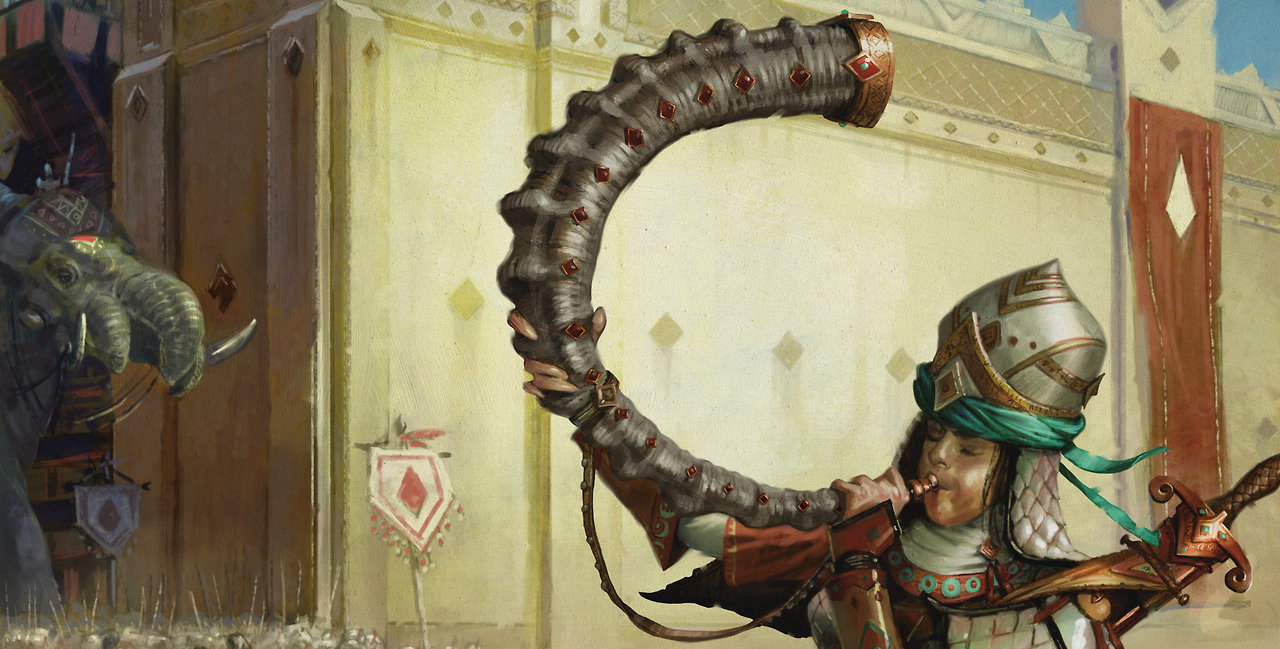A message from Don, the founder of EDHREC:
In this article, Chris is going to go through our new features on EDHREC that revolve around "themes"! I'm really excited about it because there are so many fun hidden archetypes and this should make it easier to find them. Tribes were our first theme and those were easy to pick out from the data. However, there are countless other themes, such as artifacts, +1/+1 counters, and infect that aren't really tribal, but are similar in nature. We're now detecting themes in decks and have a catalog of possible themes in one place (a lot like the tribal page). Also, you can filter commander pages to show recommendations for specific themes and tribes now. This will help sort through different ways to build a single commander. For example, Atraxa has 12 (!) unique themes and tribes captured on EDHREC. By clicking on one of them in the panel to near the top of the page, you are taken to a page that describes Atraxa just for that one particular theme.
Each themes is manually implemented, so if you think we missed a theme, hit us up on twitter or facebook and let us know!
Themes are an important aspect of deckbuilding in Commander. Themes allow us several benefits as both players and deckbuilders, but none more important perhaps than cohesiveness. That’s not to suggest that the presence of a theme necessarily indicates the presence of cohesiveness. Rather, the presence of one makes it easier to ensure the presence of the other. Now that I’m done doing my best college professor impersonation, let’s learn about a cool new function on EDHREC.
EDHREC Two-Step
There are two ways to approach using the new Theme features. One way is the top-down method, which involves already having your commander chosen and then going from there. The other is the bottom-up method, where you choose a theme before you choose your commander. Neither one is any more or less hard than the other, just different. We'll cover both over the course of this article and touch on how each method can help us.
Top-Down Method
If you already know which commander you want to build, then you are a step ahead of the game and this tool will potentially take a lot of the guesswork out of your building process. I've chosen Ertai, the CorruptedErtai, the Corrupted to build, because I feel like he doesn't get enough credit for his ability's power. All I have to do is search or navigate to him as normal.

If you look immediately to the right of the pie chart you'll notice that there is a list of themes and tribes. If you click on any one of these you'll be taken to a new, more focused recommendations page that follows the same familiar format only geared more towards that archetype. I love the synergy between the Zombie tribe's ability to recur and Ertai's ability to sacrifice them to counter things, so I'm going to choose Tribal: Zombie.

Now that I've clicked on the Tribal: Zombie link, I can see that there is a black triangle next to it notating that I have an active theme selected. On this page I can scroll down by each section and see that the recommendations are narrowed down to those that specifically synergize within the 21 decks for this archetype.
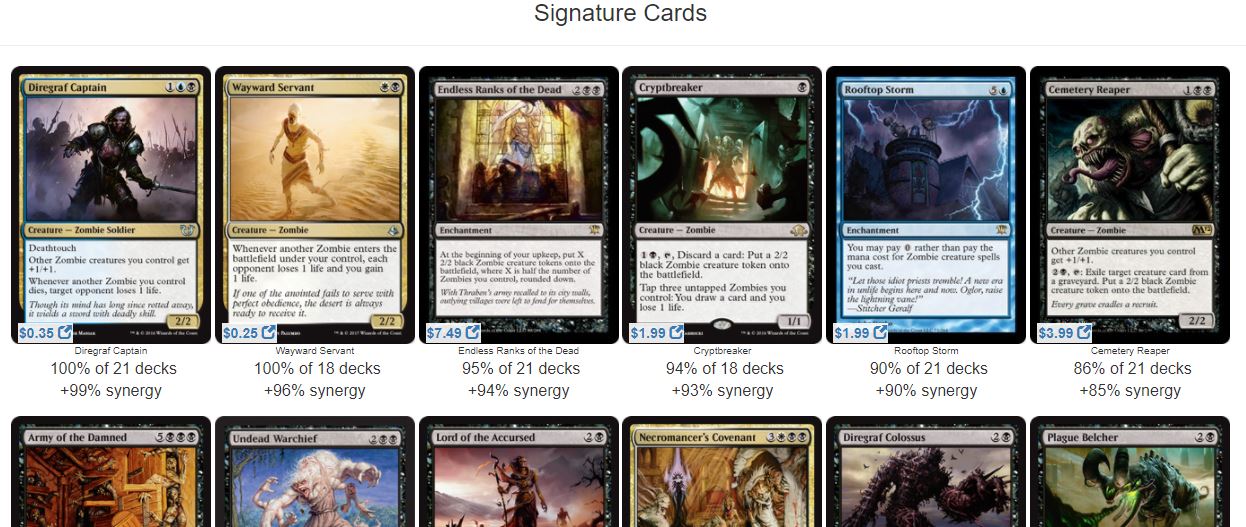
A quick scroll down to the "Signature Cards" section shows a list of recommendations that make sense for the Zombie archetype. The rest of the sections as we go down will yield more of the same as well. The theme selection tool has allowed us to effectively narrow down all of the recommendations to those most relevant to our end goal. Here's what I chose from the "Signature Cards".
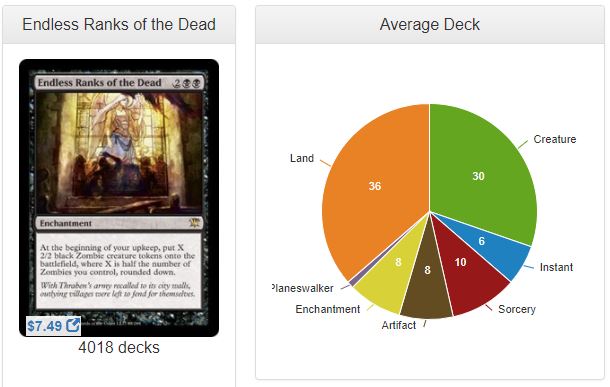
Endless Ranks of the DeadEndless Ranks of the Dead: For 4 CMC we get to create a large chunk of zombies on our upkeep. This is a perfect example of a snowball card that just gets worst the longer it's allowed to be on the table. Tokens work great with Ertai's ability so this card is a must. With 4,018 decks using it, I think it's safe to say that this card is a token/zombie staple.
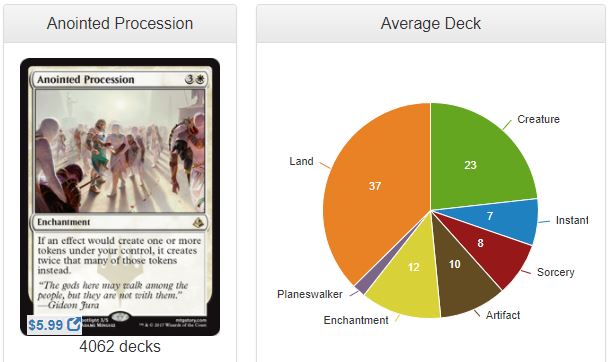
Anointed ProcessionAnointed Procession: This card is absolutely fantastic in any deck that has the ability to create tokens. It's already used in 4062 decks and for 4 CMC I see this number only getting larger.
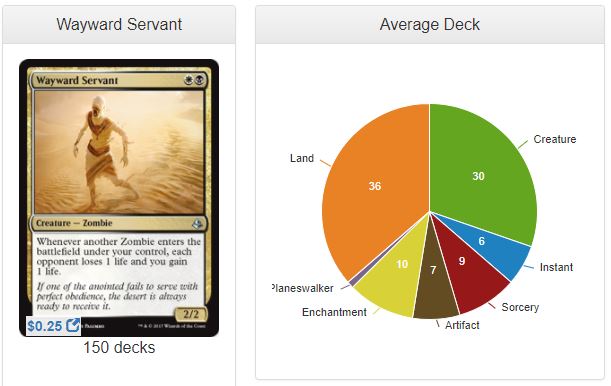
Wayward ServantWayward Servant: This card is probably my favorite of all the recent zombies. I just love the fact that it triggers off of zombie tokens and not just non-token zombies. This unsuspecting fellow has the potential to net us massive life swings, provided we go the token route, which I think is starting to look pretty good. At only 150 decks in use, I think this card has yet to show its full potential.
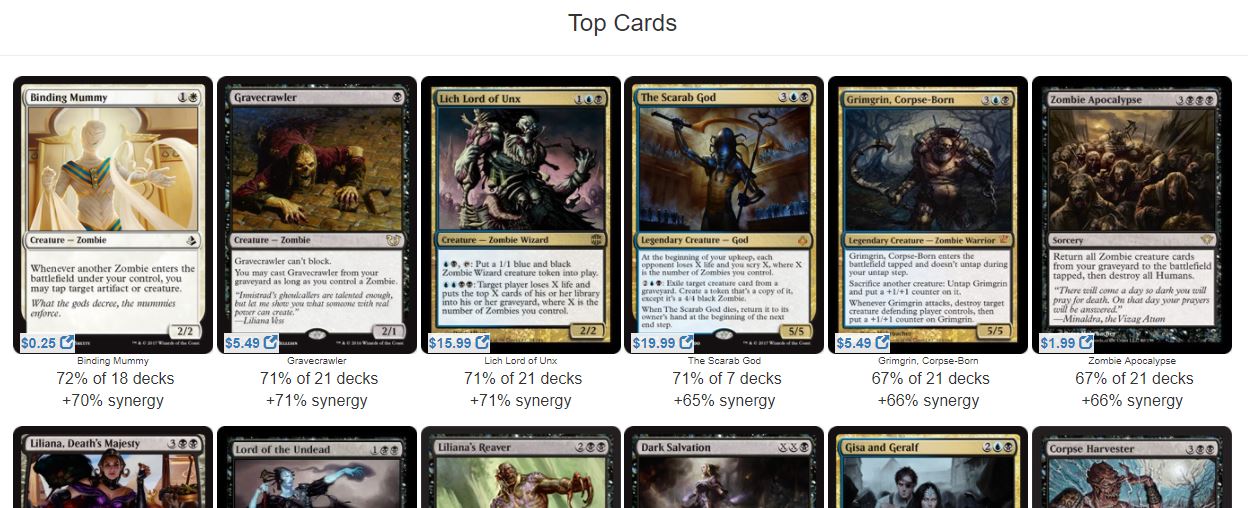
As we scroll down to the next section, "Top Cards", we can see yet again that the recommendations have been narrowed down to our archetype. As usual, there are some fantastic cards recommended in this section. I chose the following to finish out the skeleton of our deck.

Lich Lord of UnxLich Lord of Unx: Given that we are working the token sub-theme in, this card gives us tremendous value for only 3 CMC. We get another token producer as well as an alternate win-con with the second ability. It's used in 2,242 decks, so let's add to that shall we?
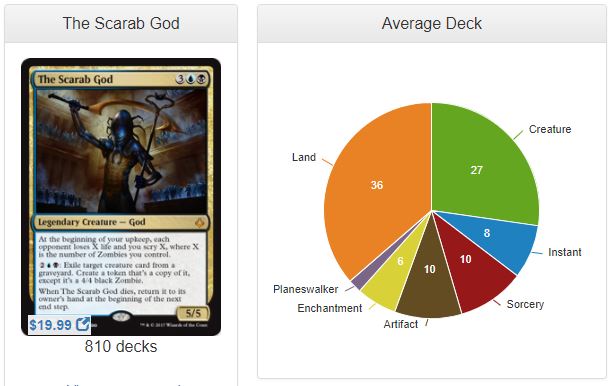
The Scarab GodThe Scarab God: Talk about a bomb! Since this card got spoiled I have not been disappointed in the amount of blowout potential it exhibits. Besides being an on-curve 5 CMC creature, you get built-in recursion along with the ability to sculpt your deck. Oh, and it also forces massive swings in life total and reanimates creatures from any graveyard. It's used in 810 decks, and I'm willing to bet it's at the helm of most of them.
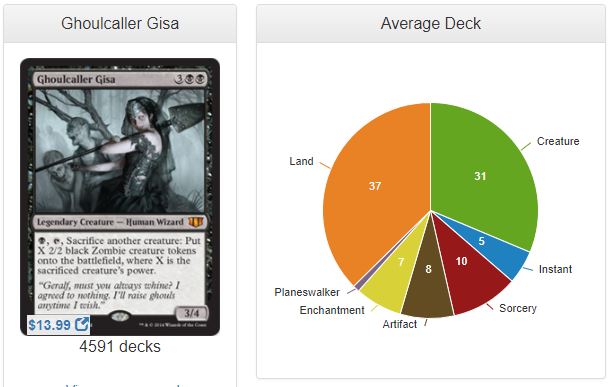
Ghoulcaller GhisaGhoulcaller Ghisa: It took this card a while to get the recognition it deserves, but she's finally at the top of the zombie token heap. She's currently used in 4,591 decks, and it's because she's downright oppressive in the right circumstances.
We will repeat the process for each section as we scroll down now that we have the skeleton for our Ertai Zombie Token build. Let's take a look at the list and see where it landed after having my options focused using this amazing tool.
Night of the Living Nope
View on ArchidektCommander (1)
- 1 Ertai, the CorruptedErtai, the Corrupted
Creatures (23)
- 1 Anointer PriestAnointer Priest
- 1 Athreos, God of PassageAthreos, God of Passage
- 1 Aura ThiefAura Thief
- 1 Aven Wind GuideAven Wind Guide
- 1 CryptbreakerCryptbreaker
- 1 Diregraf CaptainDiregraf Captain
- 1 Erebos, God of the DeadErebos, God of the Dead
- 1 Ghoulcaller GisaGhoulcaller Gisa
- 1 Grave TitanGrave Titan
- 1 Gray Merchant of AsphodelGray Merchant of Asphodel
- 1 GuileGuile
- 1 Havengul LichHavengul Lich
- 1 Lich Lord of UnxLich Lord of Unx
- 1 Lord of the AccursedLord of the Accursed
- 1 Phenax, God of DeceptionPhenax, God of Deception
- 1 Plague BelcherPlague Belcher
- 1 Shepherd of RotShepherd of Rot
- 1 Sun TitanSun Titan
- 1 The Scarab GodThe Scarab God
- 1 Undead AlchemistUndead Alchemist
- 1 Vizier of Many FacesVizier of Many Faces
- 1 Wayward ServantWayward Servant
- 1 Zur the EnchanterZur the Enchanter
Artifacts (15)
- 1 Altar of DementiaAltar of Dementia
- 1 Altar of the BroodAltar of the Brood
- 1 Chromatic LanternChromatic Lantern
- 1 Gilded LotusGilded Lotus
- 1 Lightning GreavesLightning Greaves
- 1 MindcrankMindcrank
- 1 Paradox EngineParadox Engine
- 1 Phyrexian AltarPhyrexian Altar
- 1 SkullclampSkullclamp
- 1 Sol RingSol Ring
- 1 Swiftfoot BootsSwiftfoot Boots
- 1 Talisman of DominanceTalisman of Dominance
- 1 Talisman of ProgressTalisman of Progress
- 1 Thousand-Year ElixirThousand-Year Elixir
- 1 Thran DynamoThran Dynamo
Enchantments (17)
- 1 Anointed ProcessionAnointed Procession
- 1 AttritionAttrition
- 1 Blind ObedienceBlind Obedience
- 1 Bloodchief AscensionBloodchief Ascension
- 1 Dictate of ErebosDictate of Erebos
- 1 Dictate of KruphixDictate of Kruphix
- 1 Endless Ranks of the DeadEndless Ranks of the Dead
- 1 Grave PactGrave Pact
- 1 Intruder AlarmIntruder Alarm
- 1 Land TaxLand Tax
- 1 Monastery SiegeMonastery Siege
- 1 Mystic RemoraMystic Remora
- 1 Pemmin's AuraPemmin's Aura
- 1 Phyrexian ArenaPhyrexian Arena
- 1 Phyrexian ReclamationPhyrexian Reclamation
- 1 Rhystic StudyRhystic Study
- 1 Starfield of NyxStarfield of Nyx
Instants (4)
- 1 Anguished UnmakingAnguished Unmaking
- 1 Enlightened TutorEnlightened Tutor
- 1 Swords to PlowsharesSwords to Plowshares
- 1 Vampiric TutorVampiric Tutor
Sorceries (5)
- 1 Decree of PainDecree of Pain
- 1 Demonic TutorDemonic Tutor
- 1 In Garruk's WakeIn Garruk's Wake
- 1 Kindred DominanceKindred Dominance
- 1 Living DeathLiving Death
Lands (35)
- 1 Arcane SanctumArcane Sanctum
- 1 Ash BarrensAsh Barrens
- 1 City of BrassCity of Brass
- 1 Command TowerCommand Tower
- 1 Esper PanoramaEsper Panorama
- 1 Evolving WildsEvolving Wilds
- 1 Fetid PoolsFetid Pools
- 1 Flooded StrandFlooded Strand
- 1 Forbidden OrchardForbidden Orchard
- 1 Godless ShrineGodless Shrine
- 1 Hallowed FountainHallowed Fountain
- 1 Irrigated FarmlandIrrigated Farmland
- 4 IslandIsland
- 1 Lotus ValeLotus Vale
- 1 Mana ConfluenceMana Confluence
- 1 Marsh FlatsMarsh Flats
- 1 Minamo, School at Water's EdgeMinamo, School at Water's Edge
- 3 PlainsPlains
- 1 Polluted DeltaPolluted Delta
- 1 Reliquary TowerReliquary Tower
- 4 SwampSwamp
- 1 Temple of the False GodTemple of the False God
- 1 Terramorphic ExpanseTerramorphic Expanse
- 1 Unholy GrottoUnholy Grotto
- 1 Urborg, Tomb of YawgmothUrborg, Tomb of Yawgmoth
- 1 Volrath's StrongholdVolrath's Stronghold
- 1 Watery GraveWatery Grave
In using the theme selection tool, I was able to rapidly narrow down my recommendations by themes (in this instance, tribe). I was also able to quickly pick out the tokens sub-theme from the available recommendations, which allowed me to get the skeleton of my build assembled quickly. From there, I decided to work in the mill sub-theme since there is so much synergy with zombies as well as leveraging Enchantments to further synergize with Ertai's ability. Now that you have an idea of how this works from a top-down perspective, let's take a look at the other way.
Bottom-Up Method
If you’re anything like me, you likely got hung up on searching out specific generals when you first started using the site. As you worked slowly through your list of known generals that you wanted recommendations on, you likely started browsing through generals by color(s) and getting recommendations that way. There is, however, another way to get recommendations for your deck. It also happens to be extremely focused and works great. You can get recommendations based upon theme.
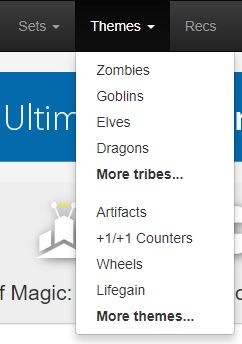
If you look at the top ribbon you’ll see the “Theme” option located between the “Sets” and “Recs” options. When you click on it, you’ll be presented with a dropdown list and some options. The dropdown is broken up into two sections, tribes and themes. For our purposes, we’ll be using the themes option for this article since I just recently published a tribal article. The four most popular themes are listed top to bottom in order of popularity above the “More Themes” option. Also note that above the themes are tribes listed in the exact same fashion. Once we click on the “More Themes” option, we are taken to a page where themes are listed in order of popularity. You’ll see below each title the number of decks associated with that theme. I feel like doing something that isn’t done very frequently, so I’m going to take the bottom-up approach to deck design and choose a theme before I choose my general. Let’s scroll to the bottom and choose “Land Destruction”.

Once we click on our choice we are navigated to a page where the recommendations for that theme are. They are split up and grouped in a familiar fashion as the categories are the same as when you are browsing recommendations by general. The extra section is the “Top Commanders”, which you may be familiar with if you have already become adventurous enough to start searching cards specifically and looking at the recommendations based upon that card. I know that Jund (red, green, black) is a strong wedge for Land Destruction, but Xira ArienXira Arien is the only commander recommended for this wedge. Given that we are building in a bottom-up fashion, I’m choosing to go with Shattergang BrothersShattergang Brothers as the general. With my general in mind, I can now scroll down and look at the recommendations for each category.

I absolutely love the “Signature Cards” recommendations. Quite often the listed cards are considered bombs for our deck. A quick inspection reveals some likely suspects in RuinationRuination, Price of GloryPrice of Glory, Impending DisasterImpending Disaster, etc. A little further down the page we have the “Top Cards” recommendations. These are cards that have the highest percentage of usage across our theme. The cards listed in this category are usually considered all-stars for our theme. The cards listed here are certainly in line with that given our Land Destruction theme. Cards like Crucible of WorldsCrucible of Worlds, Dingus EggDingus Egg, and Keldon FirebombersKeldon Firebombers are keeping in that pedigree for the theme. From these two sections, we can make some key choices and begin the skeletal framework for our deck. Given that most of the cards listed for our theme are red, we know that we will be splashing and filling in with green and black later to round out the other concepts we need to have a serviceable deck. From both sections, I’ve chosen the following cards to serve as the beginnings of our Shattergang Land Destruction deck.
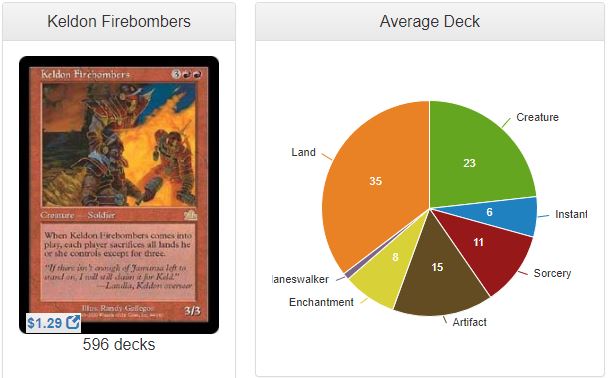
Keldon FirebombersKeldon Firebombers: A 3/3 for 5 CMC isn’t setting any records in efficiency these days, but the ability is unbelievably impactful. Taking each player back to 3 lands each time the bombers enter the battlefield is hard to deal with. This card gets downright unlivable with graveyard recursion, which our commander pairs well with. With only 596 decks utilizing it, I think this card is a shining example of this theme's unpopularity.

Price of GloryPrice of Glory: A surefire way to soak up all the control-based attention at the table is to start killing lands. Trust me, you are the worst threat to blue’s game plan and they will make it known once they catch on to what you’re doing. This card isn’t a complete resolution to that retaliation, but it’s an amazing start given that it puts them in an extremely tough situation. At 2,577 decks in use, this card is a fantastic addition to any red backed control deck.
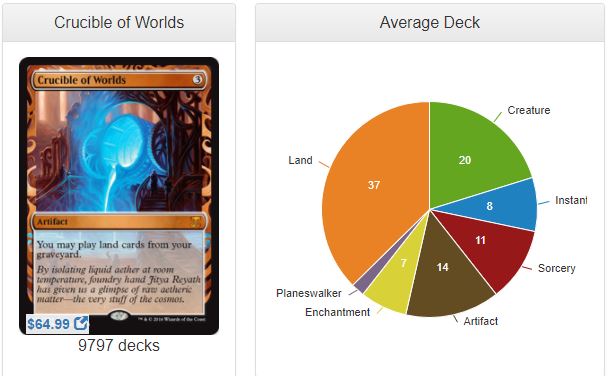
Crucible of WorldsCrucible of Worlds: This card is gross in a Land Destruction strategy. I can’t express how oppressive this card feels with Strip MineStrip Mine, WastelandWasteland, Ghost QuarterGhost Quarter, etc. Coupled with the ability to lay more than land per turn and you have a repeatable way to destroy lands that can’t be countered by traditional methods. Oh look, 9,797 decks use this card. I wonder why?
There are more than 3 cards needed to form the full skeleton of a deck, but we are going to move on for the sake of brevity. Immediately under “Top Cards” is the “Creatures” section. Here we find the list of rogues we will employ that are on our game plan. At this point I usually try to grab one creature per CMC amount from 1 to 5 that fits our strategy. This isn’t always possible, but when it is it can take the guesswork out of making the first draft of your deck feel cohesive. Here’s what I’m going to use.
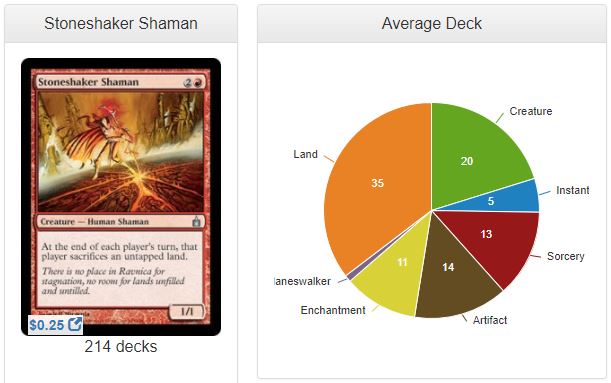
Stoneshaker ShamanStoneshaker Shaman: In any other deck this card is mediocre at best. In our deck, it’s practically a staple. It’s only used in 214 decks, and honestly, I bet most of them are among the 200-ish Land Destruction decks.
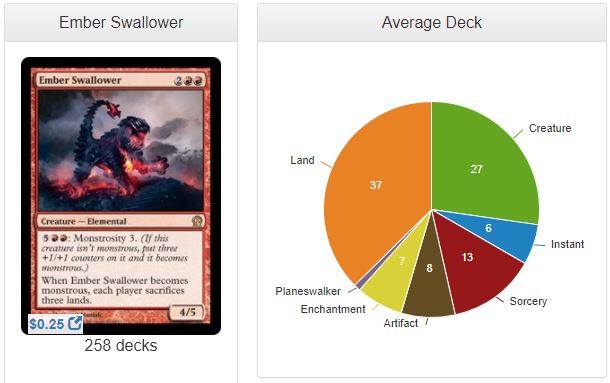
Ember SwallowerEmber Swallower: Let’s face it, this is not a good card. The stats are marginally decent for the color, the Monstrosity cost is a bit much, and it has no evasion. Nevertheless, it is a potentially large creature when we need it to be and it serves as a body that kills lands. With 258 decks in use, I guarantee it’s in the same category as Stoneshaker ShamanStoneshaker Shaman.

Deus of CalamityDeus of Calamity: This is an EDH staple from the past. It’s an efficient, trampling source of land hate and we’re going to use it. Currently it sees play in 1,071 decks, so it likely that it’s fallen out of favor in recent years with the rise of efficient beaters on its colors.
With a handful of theme specific cards and some creatures to synergize with them, we can shift our focus onto the rest of the deck. Further down the recommendations page you will see the “Instants” and “Sorceries” categories. From these two categories, we can narrow down what spells will synergize with our deck’s theme. Here’s what I choose to use.

Price of ProgressPrice of Progress: An oldie but goodie. This card has the potential to net crazy value if the circumstances are correct. There are currently 1,622 decks using it, and there’s a good reason why.

IcefallIcefall: The Recover mechanic sees very little play in just about any format. It’s usually not very desirable as there are other, usually better, alternatives to getting a spell back in hand. However, this card is versatile and the Recover ability will be fulfilled easily since we will likely be sacrificing creatures to our commander’s ability. A mere 177 decks use this card now, and we are about to add to that number.
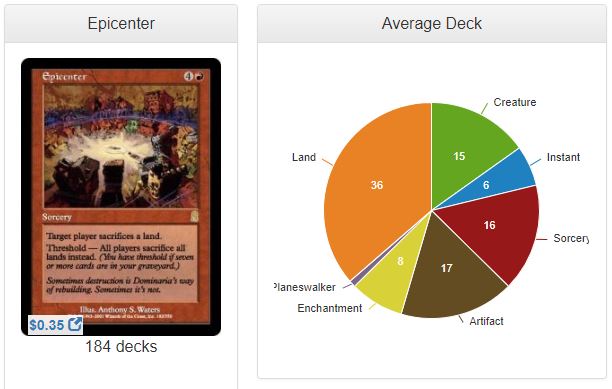
EpicenterEpicenter: This card is fantastic for us. The Threshold requirement should be easy to fulfill since we have a sacrifice oriented commander. This card is only used in 184 decks, and I’m willing to bet that its low usage is only linked to the unpopularity of the theme.
With a few spells at our disposal, we are free to look further down the page and look at the Artifacts, Enchantments, Planeswalkers, and Lands. Each of these card types has their own category of recommendations in that order. By now you should have a fair understanding of how we can use and manipulate the data held within this section to our advantage, so I’ll refrain from listing any further cards or explaining how they make the cut. Instead, let’s look at the list and focus some more on how this page and the data it contains can be leveraged to improve our decks.
[Commander]
*1 Shattergang Brothers
[/Commander]
[Creatures]
*1 Bane of Progress
*1 Deathrite Shaman
*1 Deus of Calamity
*1 Dragon Broodmother
*1 Ember Swallower
*1 Eternal Witness
*1 Glissa, the Traitor
*1 Grim Haruspex
*1 Herald of Leshrac
*1 Junk Diver
*1 Keldon Firebombers
*1 Meren of Clan Nel Toth
*1 Myr Retriever
*1 Noxious Gearhulk
*1 Oracle of Mul Daya
*1 Ramunap Excavator
*1 Siege-Gang Commander
*1 Solemn Simulacrum
*1 Steel Hellkite
*1 Stoneshaker Shaman
*1 Treasure Keeper
*1 Viashino Heretic
*1 Viridian Emissary
*1 World Breaker
*1 Wurmcoil Engine
*1 Yahenni, Undying Partisan
[/Creatures]
[Sorceries]
*1 Cultivate
*1 Epicenter
*1 Explosive Vegetation
*1 Icefall
*1 Jokulhaups
*1 Kodama's Reach
*1 Ruination
*1 Vandalblast
[/Sorceries]
[Instants]
*1 Beast Within
*1 Chaos Warp
*1 Price of Progress
*1 Putrefy
[/Instants]
[Artifacts]
*1 Birthing Pod
*1 Chromatic Lantern
*1 Crucible of Worlds
*1 Gilded Lotus
*1 Golgari Signet
*1 Mana Web
*1 Skullclamp
*1 Sol Ring
*1 Talisman of Impulse
*1 Talisman of Indulgence
*1 Thran Dynamo
*1 Worn Powerstone
[/Artifacts]
[Enchantments]
*1 Aid from the Cowl
*1 Burgeoning
*1 Cryptolith Rite
*1 Dictate of Erebos
*1 Evolutionary Leap
*1 Impending Disaster
*1 Pernicious Deed
*1 Phyrexian Arena
*1 Phyrexian Reclamation
*1 Price of Glory
*1 War's Toll
[/Enchantments]
[Lands]
*1 Blood Crypt
*1 Bloodstained Mire
*1 Bojuka Bog
*1 Buried Ruin
*1 City of Brass
*1 Command Tower
*1 Evolving Wilds
*7 Forest
*1 Ghost Quarter
*1 Glacial Chasm
*1 Mana Confluence
*4 Mountain
*1 Overgrown Tomb
*1 Reliquary Tower
*1 Savage Lands
*1 Stomping Ground
*1 Strip Mine
*4 Swamp
*1 Terramorphic Expanse
*1 Thespian's Stage
*1 Urborg, Tomb of Yawgmoth
*1 Verdant Catacombs
*1 Vesuva
*1 Wasteland
*1 Westvale Abbey
*1 Wooded Foothills
[/Lands]
[/Deck]
Wrapping Up
Whether you’re making janky kitchen table concoctions or brewing the next scourge of your local game store’s EDH league, this data can help you bring an idea into focus. By being able to look at all the recommendations for a theme, we can quickly parse many options and choose from among them the one’s that best fit the given theme. If you are used to picking a general and then working on theme(s) and sub-theme(s) from there, you may try an exercise and reversing it by choosing the theme first. Use this page to try and reverse engineer an idea into something that is your own and add to the growing number of recommendations the site contains. It's also worth noting that the "Themes" drop-down has tribes listed in the exact same fashion. I've personally found this to be an excellent resource when building a tribal deck as all the tribes are represented. I hope this helps you and would love to hear any experiences you’ve had using this page while you brew. Until next time, keep on tapping in the free world.
Christopher Russell
Chris is a mild mannered IT administrator by day, and a janky Magic player by night. He ran a private M:tG blog in a former life until he woke up one day and thought it was a good idea to post his articles where someone might actually read them.
Your opinions are welcome. We love hearing what you think about Magic! We ask that you are always respectful when commenting. Please keep in mind how your comments could be interpreted by others. Personal attacks on our writers or other commenters will not be tolerated. Your comments may be removed if your language could be interpreted as aggressive or disrespectful. You may also be banned from writing further comments.
